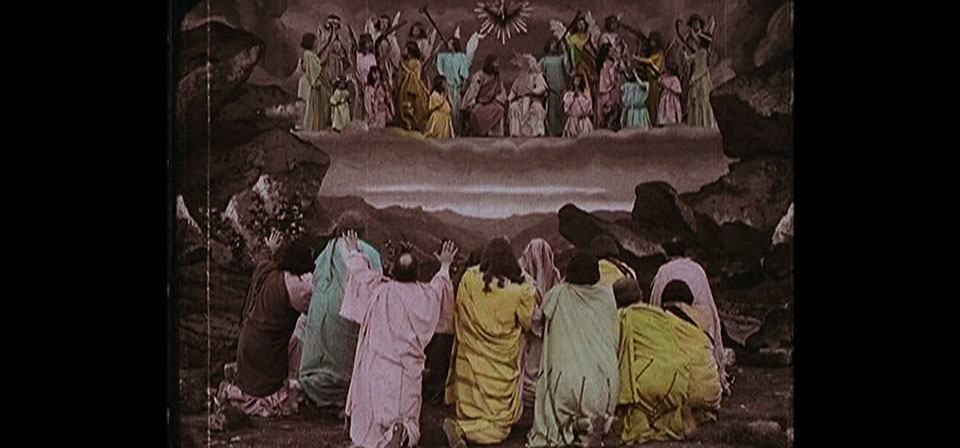The Life and Passion of Jesus Christ (1905)
The Life and Passion of Jesus Christ is a remarkable relic from the very dawn of cinema. First released in 1902 by France’s Pathé film company, it was expanded and tinkered with for the next three years, reaching its complete form in 1905. Though popular for decades after its release, it has been unavailable on video or DVD until recently, when it was released on DVD with an early American Jesus movie, From the Manger to the Cross (1912).
Caveat Spectator
Mild pageant-style depiction of Jesus’ passion and crucifixion.At a time when nearly all films were limited to one reel or less (i.e., no more than ten or fifteen minutes), The Life and Passion of Jesus Christ was a remarkably in-depth presentation of the Gospel story, running about thirty minutes at its original length and nearly three-quarters of an hour in the expanded version — one of the first long films ever.
The Life and Passion is also remarkable for Pathé’s trademark hand-coloring stencil process, in which selected individual objects — an angel’s wings, a soldier’s robe — would be painstakingly hand-dyed, frame by frame, print by print. (Entire scenes are also sometimes tinted, for example, blue to suggest night, though this was much more common and less painstaking.) Other points of technical interest include early special effects and the beginnings of camera movement in a few scenes. The two prints from which the DVD transfer were made are incredibly pristine, and the film looks terrific (better than the 1912 From the Manger to the Cross).
The film is composed of brief, pageant-like vignettes, each introduced by a simple title card such as "The Annunciation" or "The Ascension." At this early stage, the new cinematic art had yet to learn its unique strengths relative to the "legitimate theater," and so the staging of each tableau, the theatrical props and painted backdrops, and the exaggerated acting style, all typical of the era, are more evocative of a stage presentation than what came to be expected from a film only a few years later. (Compared to the 1905 Life and Passion, the 1912 From the Manger to the Cross demonstrates far more sophisticated technique, including location shooting in the Holy Land.)
Yet as an icon’s lack of naturalism is integral to its transcendent meaning as sacred art, so the Life and Passion’s very staginess and pageant-like nature have a timeless quality that encourages reflection on the gospel events themselves. Individual tableaux are visually composed to resemble sacred art (Gustave Doré is one notable influence).
There are no dialogue intertitles; as with traditional sacred art, viewers are expected to know the stories, and no effort is made to clarify for the uninitiated. (By contrast, the 1912 American film is liberally explicated with quotations from the King James Bible.) However, in many cultures it was not uncommon for silent film to be accompanied by live commentary, not unlike a contemporary DVD commentary track, and the Life and Passion was used by missionaries to introduce the gospel events to new cultures.
Catholic tradition is reflected in the narrative in a number of scenes, as when Veronica wipes the face of Christ and finds the Holy Face on the cloth, an incident not mentioned in the gospels. A common patristic saying that Christ came forth from Mary’s womb "like light through glass" is evoked in the film’s depiction of the Nativity, in which the Christ child simply appears in the manger while Mary and Joseph kneel nearby. And the tradition that St. Michael aided the Holy Family on the flight to Egypt is strikingly imagined in a scene in which the archangel blinds Herod’s soldiers to the presence of the Holy Family, literally turning the latter invisible before chasing the soldiers away.
Other scenes depict popular folk pictures or conflations of gospel stories, as when the Magi show up along with the shepherds at the Nativity, or when the miraculous catch of fishes is combined with the walking on water. Still others use the conventions of stage theater to depict supernatural events. For example, the Resurrection depicts Jesus rising up out of Sheol rather than getting up from where he was laid in the sepulchre. And in the climactic moment of the Ascension sequence (and of the film as a whole) we see Jesus, not simply ascending into the sky, but seated at the right hand of the Father with the Holy Spirit, surrounded by saints and angels.
With the possible exception of The Miracle Maker, I know of no Jesus film that makes for more accessible and inspirational viewing for children, who are much more open to the power of silent film than most adults (see "Watching Silents with Children"). My older three children (at this writing ages eight, five, and two) have watched the Life and Passion with me more than once, providing our own commentary track just like the missionaries and showmen of decades past. It’s a genuinely religious experience for them, and for me. The film’s virtues still speak to them, while the stagy production values and exaggerated stage acting pose no obstacle to them. It’s a pity more adults aren’t able to approach films like this on their own terms.
Related

The Ascension of the Lord: My favorite screen depiction
My favorite cinematic depiction of the Ascension of Jesus is one of the very first, from a very early silent film released 110 years ago.
Recent
- Benoit Blanc goes to church: Mysteries and faith in Wake Up Dead Man
- Are there too many Jesus movies?
- Antidote to the digital revolution: Carlo Acutis: Roadmap to Reality
- “Not I, But God”: Interview with Carlo Acutis: Roadmap to Reality director Tim Moriarty
- Gunn’s Superman is silly and sincere, and that’s good. It could be smarter.
Home Video
Copyright © 2000– Steven D. Greydanus. All rights reserved.